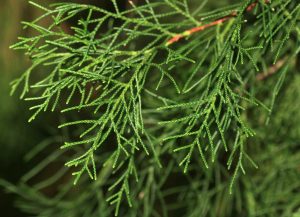 A. Common names
A. Common names
- Bhutan cypress (Silba 1986),
- Himalayan cypress (Vidakovic 1991),
- Hoàng dàn [Vietnamese] (FIPI 1996),
- (Hanzi) [Chinese]
B. Description
- An evergreen tree of 15 to 25(45) m tall, with a diameter at breast height (DBH) of 40 to 60(90) cm.
- Its crown is largely oval to broadly conical.
- It comes with thick bark, grey brown or brown in colour, and peeling off in longitudinal strips.
- Its branches are slender and drooping with thin, whip-like tips.
- Branchlets are cylindrical, nearly quadrangular, branching in whorls, and shoot in a single plane.
- Leaves are scale-like, closely appressed, obtuse, dark green, often with a small dorsal furrow.
- Male cones are subglobular, 5 to 6 mm long.
- Female cones are globose or elliptic, grouped on very short stalks, 10 to 20 mm across, green or purple when young, later turning dark brown, composed of 6 to 8(10) scales, with a small central depression and a small, triangular, reflexed mucro.
- Seeds are 6 to 8 mm to each scale and red-brown in colour. Cones appear in February to March and the seed matures in May to June. Wood is pale yellow with pale brown heartwood, and is hard and durable.
C. Cultivation Details
Himalayan cypress is a plant of the warm temperate zone, though it has also been cultivated in the subtropics and at higher elevations in the tropics, where it is grown at elevations up to 3,000 m. It grows best in areas where annual daytime temperatures are within the range of 20 to 32°c, but can tolerate 5 to 45°c. When dormant, the plant can survive temperatures down to about -9°c, but young growth can be severely damaged at -1°c. It prefers a mean annual rainfall in the range of 800 to 1,600 mm, but tolerates 650 to 2,400 mm.
- Requires a sunny position.
- Thrives in a well-drained loamy or peaty soil and can succeed in calcareous conditions.
- Prefers cooler wetter summers to other members of this genus.
- Tolerates poor sandy soils but is then more susceptible to insect damage in a succession of dry seasons.
- Subject to injury by the wind.
- Prefers a pH of 6 or lower.
- The tree is rather slow at growing.
- Cones can remain closed on the tree for several years, opening after the heat of a forest fire to scatter their seeds which then germinate and grow away quickly in the ashes of the fire.
- The crushed foliage smells of lawn mowing.
- Trees are notably susceptible to honey fungus.
Share with:
[DISPLAY_ULTIMATE_SOCIAL_ICONS]

